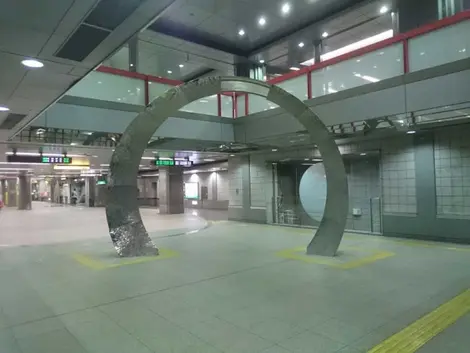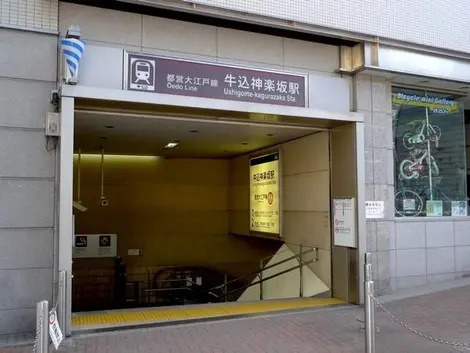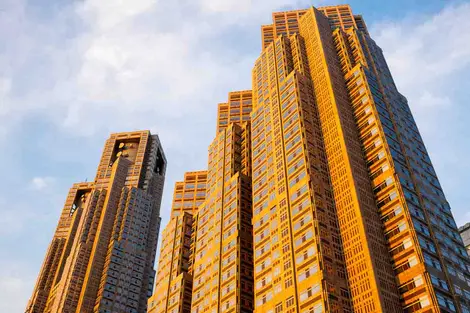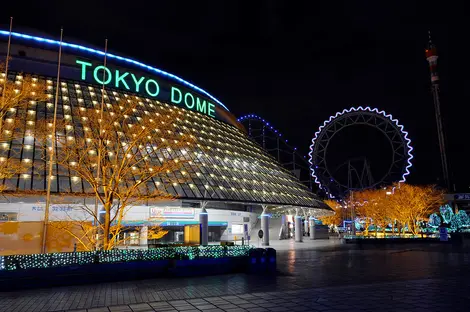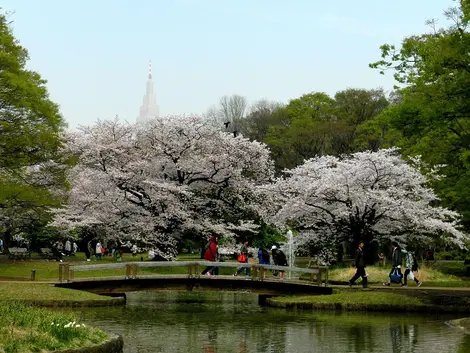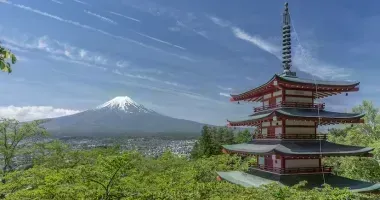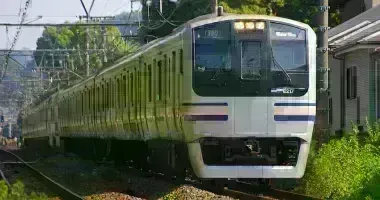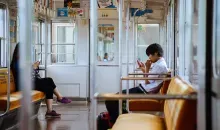Oedo Line Tokyo Subway
- Published on : 07/11/2019
- by : Japan Experience
- Youtube
Oedo Line Tokyo Subway
The Oedo Line operated by Toei is a large subway loop line around Tokyo that also has a long branch line to its north-west.
The Toei Ōedo Line is a Tokyo subway line that encircles the center of the metropolis, and with a branch from Tochōmae station extending north-west.
The above-ground JR Yamanote Line is Tokyo's other loop line. The western-most station for both lines is Shinjuku (ignoring the Ōedo Line's branch line). However, while the Yamanote Line's loop is stretched along its north-south axis, going all the way south to Shinagawa, the Ōedo Line's is stretched east-west, going all the way east to Kiyosumi-Shirakawa.
"Great Edo" Line
"Ōedo" means "Great Edo," Edo being the former name for Tokyo (in spite of the line's hub, Tochomae Station in Shinjuku, being well outside the city boundaries of old Edo).
The "Toei" indicates that it is operated by the Tokyo Metropolitan Bureau of Transportation, as opposed to "Metro" lines, run by Tokyo Metro Co., Ltd. (which, however is jointly owned by the Ministry of Finance and the Tokyo metropolitan government).
The Ōedo Line is the only Tokyo subway line with all stations underground. Being the last subway station to be completed, it is considerably deeper than the other lines, involving lots of stairs, escalators and elevators.
The Oedo Line is subway line no.12, its station numbers are prefixed with the letter E, and its color on subway maps is magenta.
History
Work began on the Oedo Line in 1986 (on the branch section, from Hikarigaoka), and was completed in 2000.
At 43.58 km long, the Oedo Line is the longest subway line in Japan. It was also Japan's most expensive subway line to build by far, costing approximately JPY 1.3 trillion - or over USD 12 billion as of the year 2000.
Oedo Line Stations
The following are the stations on the Oedo Line, with transfers and nearby attractions. Each station title includes the station name in Japanese and the station code.
0 KM - Tochōmae Station 都庁前駅 (E-28)
Tochōmae Station is considered the key, or "home," station of the Ōedo Line, in spite of not being station number "1." Tochōmae Station provides access from Exit A4 to the Tokyo Metropolitan Government building, or Tochō - a major tourist attraction for the views it affords from its top floors.
Transfer here for the Hikarigaoka branch line.
0,8 KM - 0H02 - Shinjuku-Nishiguchi Station 新宿西口駅 (E-01)
Shinjuku-Nishiguchi Station provides access to major shopping and entertainment district of Shinjuku. From here it is about 10 minutes' walk north to the Ōkubo district, with its many Korean restaurants and other businesses.
Transfer at Shinjuku-Sishiguchi Station to Marunouchi Subway Line, Yamanote Line, Chūō-Sōbu Line, Saikyō Line, Shōnan Shinjuku Line, Chūō Line, Keiō Line, Odakyū Odawara Line, Seibu Line (for access to Kawagoe).
2,2 KM - 0H05 - Higashi-Shinjuku Station 東新宿駅 (E-02)
Higashi-shinjuku Station provides access (Exit A3) to the strikingly designed Tokyo Eastside Square building, home to, among others, the video game creators, Taito Corporation.
Transfer to the Fukutoshin Line.
3,2 KM - 0H07 - Wakamatsu-Kawada Station 若松河田駅 (E-03)
The free-entry Statistical Museum, showing the history of government statistics in Japan, is 5 minutes' walk from the Kawada Exit of Wakamatsu-kawada Station.
Opening hours: 9:30 am - 5 pm; closed weekends and public holidays.
Address: 19-1 Wakamatsu-chō, Shinjuku-ku, Tokyo 162-8668 Japan (on the premises of the Statistics Bureau of Japan).
3,8 KM - 0H08 - Ushigome-Yanagicho Station 牛込柳町駅 (E-04)
Hayashi Razan (1583–1657), the Confucian scholar and founder of Yushima Seidō, is buried in a small family cemetery four minutes' walk from the East Exit of Ushigome-Yanagicho Station.
4,8 KM - 0H10 - Ushigome-Kagurazaka Station 牛込神楽坂駅 (E-05)
Ushigome-Kagurazaka Station provides access to the elevated end of Kagurazaka, a quaint and elegant district of Tokyo distinguished by its close associations with the city's literary history and culture.
Kagurazaka Station on the Tokyo Metro Tōzai Line is about 8 minutes' walk north of Exit 2 of Ushigome-Kagurazaka Station.
5,8 KM - 0H13 - Iidabashi Station 飯田橋駅 (E-06)
The Iidabashi Station area is quite heavily built-up, and with an eponymous bridge over the Kanda River.
The British Council and the free-entry TUS Museum of Science are 6 minutes' walk west of Exit C1 of Iidabashi Station.
Iidabashi Station features an unusual, futuristic design by the Japanese architect, Makoto Sei Watanabe (b.1952).
Transfer to the Tokyo Metro Tōzai Line (T-06), Tokyo Metro Yūrakuchō Line (Y-13), Tokyo Metro Namboku Line (N-10), JR Chuo-Sobu Line.
6,8 KM - 0H15 - Kasuga Station 春日駅 (E-07)
Kasuga Station is underneath the Bunkyō Ward Office, which includes the Bunkyō Civic Center Observation Lounge, a free-entry lounge, and an adjoining restaurant, on the 25th floor that offers a panoramic view of Tokyo, including Mt Fuji and the Tokyo Skytree.
Opening hours: 9 am - 8:30 pm, daily.
The pleasant enough Rekisen Park is on the west side of the Bunkyo Ward Office, but the even more attractive Koishikawa Korakuen Garden is just a little further south of it.
Tokyo Dome is immediately south of Kasuga Station.
Transfer to the Toei Mita Line (I-12), Korakuen Station on the Tokyo Metro Marunouchi Line (M-22), and Korakuen Station on the Tokyo Metro Namboku Line (N-11).
7,6 KM - 0H17 - Hongo-Sanchōmae Station 本郷三丁目駅 (E-08)
The Akamon (Red Gate) of the main campus of the University of Tokyo is a 4-minute walk north of Exit 4 of Hongo-Sanchōme Station.
The University Museum of the University of Tokyo is a natural history museum inside the university campus.
The Tokyo Waterworks Historical Museum is about 7 minutes' walk from Exit 3 of Hongo-Sanchōme Station.
Hongo-Sanchōme Station on the Ōedo Line is right beside Hongo-Sanchōme Station on the Tokyo Metro Marunouchi Line (M-21), but transfer is not possible from platform to platform. You have to come up to ground level, go out the Ōedo Line ticket gate, and then re-enter via the Marunouchi Line ticket gate.
8,7 KM - 0H17 - Ueno-Okachimachi Station 上野御徒町駅 (E-09)
Ueno-Okachimachi Station is right in the middle of the colorful market district of Okachimachi.
Transfer to Okachimachi Station on the JR Yamanote Line (JY-04) and Keihin-Tōhoku Line (JK-29) (150 meters to the west), Ueno-hirokoji Station on the Tokyo Metro Ginza Line (G-15), Naka-Okachimachi Station on the Tokyo Metro Hibiya Line (H-16).
9,5 KM - 0H21 - Shin-Okachimachi Station 新御徒町駅 (E-10)
Shin-Okachimachi Station is amid a residential area of Taito ward, and, as such, the area is characterized by a scattering of small restaurants, small businesses, and artisan studios (the latter of which there are far more of in the nearby Kuramae district).
10,5 KM - 0H23 - Kuramae Station 蔵前駅 (E-11)
Kuramae Station is in the Kuramae district of Tokyo, known for its wholesale toy stores but now with a growing number of trendy cafes, lifestyle accessory stores and artisans' workshops.
Transfer to Kuramae Station on the Toei Asakusa Line (A-17), about 300 meters south-west from Exit A6.
11,7 KM - 0H26 Ryōgoku Station 両国駅 (E-12)
Ryōgoku Station is in the middle of the Ryōgoku district of Sumida ward, across the Sumida River from Taito ward. Ryōgoku is best known as the center of sumo wrestling in Japan, but also has some excellent museums, such as the Edo Tokyo Museum - one of Tokyo's best museums for the overseas visitor.
Transfer to JR Ryōgoku Station.
12,7 KM - 0H28 - Morishita Station 森下駅 (E-13)
Morishita Station is 950 meters directly south of Ryōgoku Station, in Tokyo's Kōtō ward. Its proximity to Ryōgoku means that even here there are one or two sumobeya (sumo houses), including one of the largest, the Seki-beya. Morishita has a lot of spots associated with the haiku poet, Basho.
Transfer to the Tōei Shinjuku Line.
13,3 KM - 0H29 - Kiyosumi-Shirakawa Station 清澄白河駅 (E-14)
Kiyosumi-Shirakawa Station provides access to the big, beautiful Kiyosumi Teien Garden, a paragon of the art of Japanese-style landscaping, and the nearby Fukagawa, which is rich in historical and traditional sightseeing spots, as well as museums and hip cafes. The Shirakawa Branch Office of the Koto Ward Municipal Office is a short walk from Exit A3.
Transfer to the Hanzōmon Line.
14,1 KM - 0H31 - Monzen-Nakachō Station 門前仲町駅 (E-15)
Much of the Fukagawa district is served by Monzen-nakacho Station. The famous Naritasan Fukagawa Fudodo temple is a short walk from Exit 1 of the station.
Transfer to the Tokyo Metro Tōzai Line, station no.T-12.
12,7 KM - 0H28 - Tsukishima Station 月島駅 (E-16)
Tsukishima Station is in the Tsukishima district of Chūō ward, on one of the artificial islands in Tokyo Bay. It is in a mostly residential area, characterized by some high rise apartment buildings.
Transfer to the Yūrakuchō Line (Y-21) (within 30 minutes of exiting the Ōedo Line ticket gate if you wish to use the same ticket)
11,9 KM - 0H26 - Kachidoki Station 勝どき駅 (E-17)
10,4 KM - 0H23 - Tsukijishijo Station 月島四条駅 (E-18)
Tsukijishijo Station is in the Tsukiji district of Chūō ward. Tsukijishijo means "Tsukiji Market," and Tsukijishijo Station is beside what used to be Tokyo's major seafood and produce market, before it moved in 2018 to Toyosu Market, almost 3 km south-east.
However, much of the old Tsukiji Market remains open - it has simply reoriented itself to consumers instead of wholesalers - and is worth visiting for its fresh seafood restaurants and many stalls selling food and handicrafts.
The impressive Indian-style Tsukiji Honganji Temple about six minutes walk from Exit A1 of Tsukijishijo Station is also worth a look for its pre-war antiqueness, its vast incense-laden, cathedral-like interior and carved golden altar. You will likely see a ceremony taking place before the grand altar if you stop in.
South of the station, Hamarikyū Garden is an 8-minute walk from Exit A2.
9,5 KM - 0H21 - Shiodome Station汐留駅 (E-19)
Shiodome Station is near the big, futuristic Shiodome Shiosite complex in Tokyo's Shinbashi district.
The old Shimbashi Station (now a museum) is just out of Exit 3 of Shiodome Station.
Hamarikyu Garden is an 8-minute walk from the East Exit.
Transfer to the Yurikamome Line (U-02).
8,6 KM - 0H19 - Daimon Station 大門駅 (E-20)
Daimon Station is in the Hamamatsucho district of Minato ward, Tokyo.
Daimon Station adjoins Hamamatsuchō Station.
Just outside exit B3, you can go up to the 40th-floor World Trade Center Building Observatory Seaside Top, a viewing deck 152 meters up, for a panoramic view of Tokyo. Take in the nearby Tokyo Tower and Odaiba, the Tokyo Skytree, and sometimes even Mt. Fuji. Hours: 10 am to 8:30 pm, daily. 620 yen.
Transfer to the Toei Asakusa Line. There is indirect transfer via Exit B2 to the adjacent Hamamatsucho Station for the Yamanote Line (JY-28), Keihin-Tohoku Line (JK-23), and the Tokyo Monorail Haneda Airport Line (M-0).
7,3 KM - 0H16 - Akabanebashi Station 赤羽橋駅 (E-21)
Tokyo Tower is 10 minutes walk from the Nakanohashi Exit of Akabanebashi Station, and Shiba Park, with its many attractions, is only 4 minutes.
Akabanebashi is the name of the nearby bridge, which dates from at least the 17th century, but was last rebuilt in 1974 and is overhung by an elevated highway.
6,5 KM - 0H14 - Azabu-jūban Station 麻布十番駅 (E-22)
Azabu-juban Station is in the eponymous area of Minato ward, characterized by its concentration of foreign embassies in Tokyo.
5,4 KM - 0H12 - Roppongi Station 六本木駅 (E-23)
Roppongi Station provides access to the shopping, dining, art and nightlife district of Roppongi. Roppongi bars and drinking is the main reason for visiting after dark. During daytime hours, the area is dominated by the following Big Three: Roppongi Hills (4 minutes walk from Exit 3), Tokyo Midtown (0 minutes from Exit 8), and the National Art Center Tokyo (4 minutes walk from Exit 7).
Transfer to the Hibiya Line (H-04).
4,1 KM - 0H09 - Aoyama-Itchōme Station 青山一丁目駅 (E-24)
Aoyama is a prominent youth fashion district of Tokyo, full of clothing boutiques and trendy cafes. Aoyama-itchōme (itchōme meaning "1-chōme") provides access to the middle of the Aoyama district, on the intersection of Aoyama-dōri Avenue and Higashi Gaien-dōri Avenue.
Geihinkan Akasaka Palace occupies the large expanse of land known as Akasaka Goyochi (Akasaka Estate) north-east of Aoyama-itchōme Station (Exit 2).
Aoyama Cemetery, containing the graves of a great many famous Japanese and foreigners, is south-west of Aoyama-itchōme Station (Exit 5).
Transfers: Aoyama-itchōme Station intersects with the Tokyo Metro Hanzōmon Line (Z-03) and Tokyo Metro Ginza Line (G-04), which run parallel along this stretch of Aoyama-dōri.
2,7 KM - 0H09 - Kokuritsu-Kyōgijō Station 国立競技場駅 (E-25)
Kokuritsu-Kyōgijō Station is right on the border between Shinjuku ward to the north and Shibuya ward to the south. The whole area south of the station is full of sports grounds. The station takes its name from the Olympic Stadium that stood near here between 1958 and 2014. This station also goes by the name of "Tokyo Taiikukan-mae" ("in front of Tokyo Gymnasium"), as the Tokyo Metropolitan Gymnasium is also right by the station, to the south-west (Exit A3).
A new stadium, the National Olympic Stadium, is being built just to the south-east of the station to replace the demolished stadium in time for the 2020 Olympics.
The Meiji Memorial Picture Gallery - Kaigakan is a short walk from the station (Exit A1).
The Meiji Jingu Ice Skating Rink is just north of the station.
Shinjuku Gyoen National Garden is also not far to the north of Kokuritsu-Kyōgijō Station, but the nearest entrance is a long walk, therefore access from Kokuritsu-Kyōgijō Station is not recommended.
Transfer to Sendagaya Station on the Chūō-Sōbu Line (Exit A5).
1,4 KM - 0H04 - Yoyogi Station 代々木駅 (E-26)
Yoyogi is a mainly residential area just south-west of Shinjuku Station. From Exit A1 it is about a 5-minute walk south to the Kita-Sando Entrance of Meiji Jingu Shrine, beyond which is Yoyogi Park.
Transfer to the Yamanote Line (JY-17) and the Chuo-Sobu Line (Exit A3).
0,8 KM - 0H02 - Shinjuku Station 新宿駅 (E-27)
Shinjuku Station on the Ōedo Line is on the west side of the massive Shinjuku Station. The commercial district that is Shinjuku is a city unto itself, with a 24-hour buzz and almost every possible product and service available in a 1-kilometer radius around the station: Shinjuku shopping is second to none.
West of the Ōedo Line Shinjuku Station is the west Shinjuku central business district of commercial skyscrapers and the massive Tocho (Tokyo Metropolitan Government Buildings).
On the other - east - side of Shinjuku Station from the Ōedo Line is the sleepless Shinjuku entertainment district, catering to every possible taste and budget. This includes the bohemian drinking alley of Golden Gai ("Golden Alley"), the LGBTQ quarter of Shinjuku Ni-Chōme, and lots of other Shinjuku night life.
Transfers: The Shinjuku station area is a dense network, so, for this station, the exits and the facilities they lead to are set out below.
Exit 2 (6 am to 10:30 pm): South Entrance of JR Shinjuku Station
Exit 3: Busta Shinjuku bus terminal
Exit 4 (6 am to 11 pm): Koshu-kaido Street
Exit 5 (6 am to 11 pm): Shinjuku Post Office
Exit 6 (6 am to 11 pm): Bunka Fashion College Tokyo, Zenrosai Hall/Space Zero
Exit 7 (6 am to 11 pm): Keio Plaza Hotel
Exit 8 (6 am to 11 pm): Tokyo Metropolitan Government Building - Tocho (more directly accessed from Tochomae Station), Shinjuku Washington Hotel
0 KM - Tochōmae Station 都庁前駅 (E-28)
The train has barely left Shinjuku Station before it stops, after taking a right-angled left turn, at Tochomae Station, which provides direct access to the Tokyo Metropolitan Government Building - Tocho. Here is also the Hyatt Regency Tokyo (Exit C4), Keio Plaza Hotel (Exit B1), and the Shinjuku Tax Office (Exit C6). Shinjuku Chuo Park is just west of Tocho.
Tochōmae is the hub between the Ōedo loop line and the Ōedo branch line. As such, it is at the "9 o'clock" position on the loop line, with the branch line extending up north-west from it.
Platform 1 trains come from the branch (starting station: Hikarigaoka Station), enter the loop at Tochōmae, and go anti-clockwise, i.e., from "9 o'clock" heading for "6 o'clock" and beyond. Platform 2 trains start at Tochōmae and go clockwise, i.e., from "9 o'clock" heading for "12 o'clock" and beyond. Platform 3 trains come from "12 o'clock" and beyond, anti-clockwise around the loop, and terminate at Tochōmae. Platform 4 trains come from the "6 o'clock" direction, clockwise around the loop, and from Tochōmae head out up the branch line.
0,8 KM - 0H02 - Nishi-Shinjuku-Gochōme Station 西新宿五丁目駅 (E-29)
Nishi-Shinjuku-Gochōme Station is the first station on the Ōedo branch line that extends north-west from Tochōmae station, and serves a mostly residential part of Shinjuku ward.
2 KM - 0H05 - Nakano-Sakaue Station 中野坂上駅 (E-30)
Nakano-Sakaue (pronounced "na-ka-no sa-kah-oo-eh") Station is in Nakano ward, and is the second station on the Ōedo branch line that extends north-west from Tochōmae station. Nakano-sakaue Station is at the top of a slope on Omekaidō Avenue and, being near Shinjuku, has its share of large commercial towers containing some stylish shopping and dining. These include the Across City commercial center, near Exit A1.
Jōgan Temple is a large Sōtō Buddhist temple founded in the fifteenth century and has a distinctive Chinese-looking gate. Jōganji is about 6 minutes walk south of Nakano-Sakaue Station down Yamate-dōri Avenue.
Hosenji is another, even older, Buddhist temple, with an elaborate five-story pagoda, about 5 minutes' walk north-west of Nakano-Sakaue Station.
Transfer to the Tokyo Metro Marunouchi Line (M-06). (The 3-station branch line of the Marunouchi line comprising Nakano-Shimbashi, Nakano-Fujimichō and Hōnanchō stations starts at Nakano-Sakaue Station.)
3,0 KM - 0H07 - Higashi-Nakano Station 東中野駅 (E-31)
Higashi-nakano Station is the third station on the Ōedo branch line that extends north-west from Tochōmae station. The stylish Atre Vie Higashi Nakano shopping building is very near the station.
Transfer to the Chūō-Sōbu Line (JB-08) (Exit A1). From Exit A2, it is 8 minutes' walk to Ochiai Station on the Tokyo Metro Tozai Line (T-02).
3,8 KM - 0H08 - Nakai Station 中井駅 (E-32)
Nakai Station is the fourth station on the Ōedo branch line that extends north-west from Tochōmae station. Exit A1 opens out onto the big Yamate-ōori Avenue, with few facilities. Exit A2 is on the small Nakai Shoyukai shopping mall running along Nakai-Ekimae-dōri Street, with a close-knit, several decades old flavor. The Myōshōji River is a short walk away, left out of the exit.
Transfer to the Seibu Shinjuku Line (SS-04) by going left out of Exit A2 (1 minute's walk). From Exit A1 (go right out of the exit), it is 5 minutes' walk to Ochiai Station on the Tokyo Metro Tōzai Line (T-02).
5,1 KM - 0H11 - Ochiai-Minami-Nagasaki Station 落合南長崎駅 (E-33)
Ochiai-minami-nagasaki Station is the fifth station on the Ōedo branch line that extends north-west from Tochōmae station. The station is on the busy Prefectural Highway No.8, and has some large commercial facilities nearby, including the iTerrace Ochiai-Minami-Nagasaki shopping complex and the Minami-Nagasaki Sports Center.
Famous manga artists such as Osamu Tezuka (1928-1989), Fujio F. Fujiko (1933-1996), and Shōtarō Ishinomori (1938-1998) lived in this area, so there are often manga-themed events going on. The famous Tokiwa-sō apartment building existed here a little west of the station between 1952 and 1982, where the above artists, and several others, lived. There is a small monument to Tokiwa-sō on the site where it once stood, which is where the Nihon Kajo Publishing Company now is. Also, in Minamigasaki Hanasaki Park is a "Tokiwa-sō Heroes" monument. The Tokiwasō-dōri Rest Spot is another related facility in the area, which has a recreation of what the inside of Tokiwa-sō looked like.
6,7 KM - 0H13 - Shin-Egota Station 新江古田駅 (E-34)
Shin-egota Station is the sixth station on the Ōedo branch line that extends north-west from Tochōmae station. There is a little commercial activity around the station, but not much. Egota-no-Mori Park is six minutes' walk south-west of Shin-Egota Station. The Egota Campus of Musashi University is six minutes' walk north-west of Shin-Egota Station.
8,3 KM - 0H16 - Nerima Station 練馬駅 (E-35)
Nerima Station is a large and important hub station that the Ōedo Line shares with three lines operated by Seibu Railway. It is the seventh station on the Ōedo branch line that extends north-west from Tochōmae station.
The Coconeri shopping mall is right next to Nerima Station, and just beyond Coconeri is Heisei Azalea Park and the Nerima Cultural Center.
Transfer to the Seibu Ikebukuro Line, the Seibu Toshima Line,and the Seibu Yūrakuchō Line.
9,2 KM - 0H18 - Toshimaen Station としまえん駅 (E-36)
Toshimaen is the eighth station on the Ōedo branch line that extends north-west from Tochōmae station. Exit A2 provides access to the famous Toshimaen amusement park. The commercial area that includes the United Cinemas Toshimaen complex is even closer. Just across from Exit A1 is Tajimasan-juuikka-ji Temple: actually a collection of 11 related Zen temples occupying the same street, moved here 14 km west from Asakusa following the great 1923 Tokyo earthquake. The Shakujii River runs east-west just a little north of the station, if you walk up Toshimaen-dōri Avenue.
Transfer to Toshimaen Station, the starting station on the Seibu Toshima Line. From Exit 2, walk two minutes along the Toshimaen Shotengai shopping street.
10,7 KM - 0H20 - Nerima-Kasugachō Station 練馬春日町駅 (E-37)
Nerima-kasugacho Station is the ninth station on the Ōedo branch line that extends north-west from Tochōmae station. It is in the middle of an almost completely residential area, with a few commercial establishments nearby. A short walk from Exit A2 is a monument to the loca Ōyama-dō, or road that pilgrims to Mt. Ōyama used.
12,1 KM - 0H22 - Hikarigaoka Station 光が丘駅 (E-38)
Hikarigaoka Station is the tenth and final station on the Ōedo branch line that extends north-west from Tochōmae station.
The area surrounding Hikarigaoka Station, in Nerima City, is dominated by highrise apartment buildings, but there is considerable commercial activity, which includes the large Hikarigaoka IMA mall right next to the station. About five minutes walk east of the station is the small Hikarigaoka Art Museum. And about 11 minutes' walk north of the station is the big, green Hikarigaoka Park.
The nearest stations on other lines are:
- to the north-east: Chikatetsu-Akatsuka Station on the Yūrakuchō and Fukutoshin subway lines and, just beyond it, Shimoakatsuka on the Tōbu Tōjō Line. Both these stations are about half an hour's walk north-east of Hikarigaoka Station.
- to the south: Nerimatakanodai, Fujimidai, and Nakamurabashi stations on the Seibu Ikebukuro Line. These three stations are about 35 minutes' walk north-east of Hikarigaoka Station through quite difficult to navigate routes.
Tips for Riding the Ōedo Line
Here are some useful tips for using the Ōedo Line (and all other trains in Japan).
1. First buy a pre-paid smartcard, such as a Suica or Pasmo (if purchased in Tokyo, different if purchased elsewhere). They require a refundable 500 yen initial charge, but make subway use much easier than having to buy a paper ticket at a station whenever you ride a train. Simply touch the card for a second on the sensor at the ticket wicket as you pass through.
2. Identify in advance the number of the exit you will need to take at the destination station and ...
3. having identified that exit, board the car closest to that destination exit. You will save time (and be less likely to get lost) if you can board the car that will stop closest to the destination station exit you will leave from. There are charts for that purpose on the station wall, telling you the appropriate cars for each exit at each station, or you can ask a station attendant. "[Station name] no deguchi ni oriru no de, dono sharyō ni noreba ii desu ka".
4. Mind your manners. Don't eat or drink on the train, remove your backpack if you're standing, don't put luggage on the seat beside you, don't talk on your cell phone, and if you're talking to people, try and keep it subdued.




